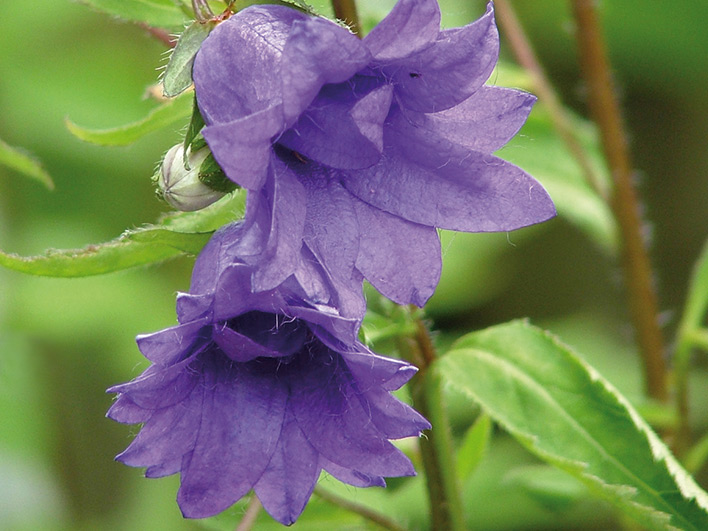Campanulas (Bellflowers)

The Latin means ‘little bells’ and they come in 100s of different forms.
Campanula Pyramidalis (Chimney Bellflower) is usually grown as a biennial, reaching 1.8M. The flowers don’t last long once pollinated — so the plant used to be grown indoors in pots as a summer ornament for the fireless grate. It has been grown in the UK since before 1596 when it was originally known as Steeple-bells.
In the 16th and 17th Centuries Canterbury Bells (Campanula Medium) were called Coventry Bells because it was thought they grew in profusion around Coventry. This was later dismissed, because they weren’t. At that time the name Canterbury Bells was given to Campanula Trachelium as some thought the bells resembled those attached to the pilgrims’ horses’ harness travelling to Canterbury.
Campanula Trachelium also now known as Nettle Leaved Bellflower, Bats in the Belfry or Throatwort is an extremely easily grown perennial, if not a thug! Throatwort refers to the Greek word for throat — trachelos, when it was used as a gargle. It grows to about a metre high in sun or shade and can have blue, or less common — white flowers. It is an attractive plant, but seeds everywhere and the root is so thick and strong it is difficult to eradicate but consequently is very useful for areas which need to look after themselves.
A very attractive form is the blue double flowered C.Trachelium (Bernice). However, this is nothing like as vigorous as the single-flowered form.
Campanula Lactiflora (Milky Bellflower) from Siberia (1814) is a lovely plant growing to about 1.5M high and en masse looks good with shrub roses. Reliable forms are Loddon Anna which is pink and also Prichard’s Blue. With masses of medium to small bellflowers they can be Chelsea-chopped to stagger the flowering and when regularly dead-headed will carry on for a long time.
Campanula Latifolia (Wide Leafed Bellflower/Great Bellflower) is another good campanula for growing with shrub roses to produce the cottage garden look. Growing to about 1.2M this has large bells again generally in blue to white.
Campanula Persicifolia (Peach Leafed Campanula) is an easy to grow and relatively slug-free plant. One of my favourites is Chettle Charm which has white flowers with a picotee edge of pale blue. This grows to usually less than 1M.
Campanula Punctata (Spotted Campanula) is easily grown from seed and quite often has deep pink very large bells on a plant about 60cm high. I have found the slugs like this one and it is prone to the rust fungus, akin to that found on hollyhocks. A lovely cross C.Punctata with C.Trachelium is C.Sarastro from the Sarastro Austrian Nursery, which has impressive big dark purple blue flowers. It is a better plant than C.Punctata and also does not seed around like C.Trachelium.
Other campanulas are of course, the ones you see growing out of walls, most commonly known as C.Muralis with masses of blue bells, and there is the native Harebell (C.Rotundifolia) found in mountains. An unusual but attractive plant is Campanula Alliariifolia which is clump forming and has strings of white bells on a 50cm plant.
Norman Jenkins & Claire Jenkins (MCIHort)
Bordervale Plants, Ystradowen, Cowbridge, CF71 7SX
01446 774036
Back to Readers CornerWe know our patients read the Village Directory, their feedback tells us that many use it as a valuable reference point for all local services and phone numbers as well as a great monthly read. We have found it invaluable in ensuring our name is seen — Kathryn LowryDavies & Lowry Optometrists